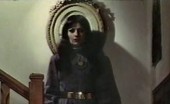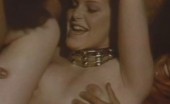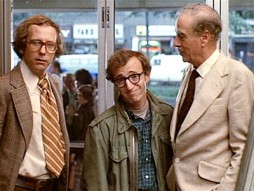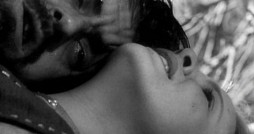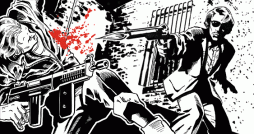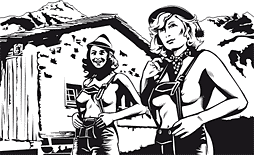Ein Interview mit Wakefield Poole / An interview with Wakefield Poole
Von Redaktion // 17. August 2011 // Tagged: featured, Interview, Pornfilmfestival 2012, Porno, Queer, Wakefield Poole // Keine Kommentare
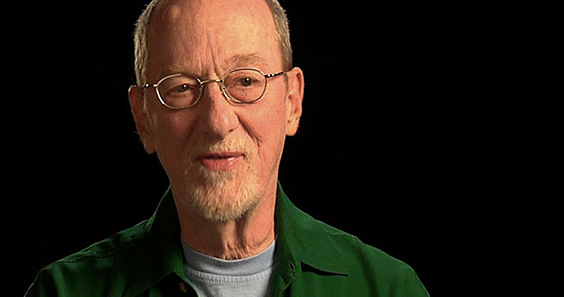
Wakefield Poole is one of the directors who created the porno chic in the 1970s: His first feature film Boys in the Sand was a tremendous box-office hit and was reviewed in newspapers like the New York Times, thus being ahead even of Gerard Damianos Deep Throat. Jim Tushinski’s documentary Dirty Poole, in which Wakefield Pooles life between Broadway and porn, art collection and drug abuse is scrutinized, is still awaiting distribution but will hopefully be shown at film festivals soon. Due to luck and application we were given the opportunity to interview this pioneer of porn via e-mail.
Hard Sensations: Initially, what made you gather private money to finance your first porn movie? Was it just for the sake of adventure or were you convinced from the start that directing movies was something you were good at?
Wakefield Poole: I made Boys In the Sand (Bits) using my credit cards. It was just an experiment to see if one could make a porno film that was not degrading and ugly. I had been doing some experimenting with film through multi media shows for Triton Gallery so when I got the idea to try, I just made one segment for fun. I never intended it to be shown publically. After friends and my manager saw it they encouraged me to make a full length film by adding a few more segments. My manager became my partner and that’s how it started.
HS: We assume you didn’t work with professional actors in the beginning. What made men act in your movies, what were their motives? Did they know exactly about the scenes they were in, and what did they do in their every day lives?
WP: Originally, two of my housemates on Fire Island were going to do the segment. They were lovers and thought it would be fun. Alas as happens so often, when it was time to do the filming they both had second thoughts. I was all prepared so I asked my lover Peter, if he would do it with a guy named Danny who worked at the gift shop on the island. We were going to have a threesome with him so I asked if he would like to make a sex film with Peter and he accepted. We had no thought of releasing it so it was just a friendly get together. Like many plots of Judy Garland movies, “Let’s get together and put on a show in the barn”. Peter was a computer system analyst as well as being my lover of two years at that time.
HS: The actors in your movies often show rather acrobatic abilities (which even remind of Kama Sutra or ancient greek images). Each of them has his own imaginative style and individual technique. In your comments to Boys In the Sand you say that you leave your actors a lot of freedom (which actually pays off in the resulting scenes, because they are just beautiful and enjoyable). Can you comment further on that?
WP: I never direct actors as to what sex acts I want them to perform at any specific time. I make sure that there is mutual desire and respect for each other. That is the freedom I spoke about. I wanted everything to come naturally. If I told them what to do they would not have the confidence to know if they were doing as they were told. Therefore doing what comes naturally is really truth from a sexual point of view. The scenes become real.
HS: Calvin Culver was the main character in several of your movies. Was he a friend or was it just a professional relation?
WP: Cal Culver was recommended to me when I needed a replacement for Danny. When Danny found that we were planning to release it commercially he wanted an outrageous amount of money. I found that I could remake the scene for less money than what he was asking. The Gods were in my favor because Cal was a natural, and added much to the success of the picture. He also was an incredible person. He was a school teacher and after Bits opened he became an instant star. We remained good friends, working together many times.
HS: In the 60s, you were working on Broadway and came to know a lot of famous people. Can you tell us something about the times before your career in the film business?
WP: In the decade of the 60’s, I did 12 Broadway shows and all the big TV shows, working with some of the greats in the business. Richard Rodgers, Noel Coward, Steven Sondheim, Arthur Laurents, George Abbot, and Joe Layton on the production end. Some of the performers I worked with as a dancer, director or choreographer include Liza Minnelli, Angela Lansbury, Joel Grey, Carol Burnett, Alexis Smith, Howard Keel, Gordon Macrae, Shirley Jones, Dorothy Collins and so many more. I worked almost solidly for the entire 60’s. I learned so much and had a wonderful time of it.
HS: What was/is your realtionship to the (Westcoast-) art-scene like? Some of your settings remind of David Hockney’s Swimming-Pool Paintings.
WP: I always went to museums even as a teenager but when I became successful I began to become a collector of Pop Art. My first big purchase was Warhol’s Marilyns the 10 silkscreen series. At one point I owned 24 Warhol’s, four Lichtenstein’s, 3 Oldenburg’s 2 Jim Dine’s 2 Rusha’s and 1 Jasper John’s, 1 Nancy Grossman and a few less well known artists. I was very much into the NY art scene. By the time I moved to California in 1974 I was pretty much finished as a collector. I do appreciate many of the west coast artists but didn’t get into the scene as I had in NY.
HS: How far did your work as a choreographer influence your movies? Coming from the theatre, were you interested in cinema in general at all?
WP: My training and dancing in the Ballet Russe in 1957 & 1958 played a great part in my artistic bent. I was on my way to being a fairly well know choreographer when I made Bits but the success of that film and the fact I proudly put my name above the title of a sex film put the nail in the coffin of my theater career. The most influence was in the music I chose to accompany my sexual romps. People began to have sex to classical music as apposed to rock or other choices. It was a romantic period.
HS: There is a lot of musical sense in Boys In the Sand, like in a loose and improvised jazz session. The atmosphere reminds of the movie Jazz on a Summer’s Day. About the the last episode you said: “They played each other like instruments”…
WP: Music is most important in my movies as I have no dialogue. The music set the mood for each segment. It can be varied as I did in Bits. Debussy to Beach Boys to Indian music. Each fits it’s section very well and give a variety to the scenes.
HS: Boys In the Sand was a big sucess. Could you pick up on that instantly or did making porn movies remain a “hobby” whilst still working for stage productions?
WP: As I said after the success of Bits I had no choice but to stay on the road I had taken. I made a vast amount of money in a short period of time and immediately went into production of Bijou. It was released exactly ten months after Bits as was as big a success. There were no more theatrical offers. It was as if I became another person and Wakefield Poole, Broadway dancer and choreographer had died. Most of my gay friends staid but I heard very little from my straight theater friends.
HS: Moving! has a lot in common with Boys in the Sand. It uses the same strategies of storytelling and alienation, yet the porn scenes are more explicit. Does the fisting scene meet your personal taste, or did you use it in Moving! for mere commercial reasons?
WP: Moving! is very much in the same vein as Bits. After Bijou I made a soft core straight film of four stories from the Bible. It was a tremendous flop and cost me 150,000. It really is a beautiful film but everyone wanted hardcore sex. It was also the time of the Deep Throat trials. Not a good time for Porno. Michael Bennett was preparing A Chorus Line. Michael was a good friend and also managed by my partner Marvin Shulman. Michael wanted to take a year off to work on the show so Marvin asked me to do another film to generate cash flow for us. I made Moving! for the same amount I made Bits. $4,800. I had to rely on my talent and not production. We ended up paying for the workshop productions of Michael’s show. Not bad for an inexpensive gay porno movie. Michael never denied our contribution to his success.
HS: The old times, the Golden Age of Porn: Happy Hippies and the Vietnam War. The liberation of body and mind and drug addiction and, in the end, Aids. What is your perspective on those times now? The idea of „Make love not war“ has been abondoned. Things that started back in those days have not been continued. Not only in porn business, there was a break between the „Golden Age“ and the „Plastic Age“. Do you have a theory about what has changed in terms of sexuality and society in general – and why? Do you enjoy the present times, or do you get nostalic when you think of the 70s?
WP: As far as the good old times. Every generation has its golden years of “whatever”. I lived through the golden ages of Broadway, Television, Movies, Porno, coming out, free love, drugs, relationships and who know what else. Of course I look on all these with nostalgia. Most of my friends were still alive then. That has been the most difficult. The most dramatic changes were brought about by the onslaught of AIDS. The disease changed and touched everyone. The 70’s were the most exciting decade followed by the horrific 80’s. I do enjoy my time now but in a very different way. I have been celibate for over 25years so sex plays no role in my life. I still enjoy looking at a pretty face but am content to just appreciate it. I’m 75 years old now and that’s how it should be.
HS: You stated the The Doors were your favorite band. They are amongst the most melancholic and abysmal bands of those days, and the dark side of sexuality was one of their major topics. This kind of darkness lingers in Moving! and Boys in the Sand as well. Not on the surface, but as some kind of summerly suspense, almost like a deadlock. The sun shines every day and people are in that kind of trance in which thoughts are exhausting and sensuality comes effortlessly…
WP: The Doors along with Pink Floyd still remain my favorite bands because of their darkness and depth but on the other side, Richard Strauss is also in that category. There is a reason most S&M people fill the opera houses when ever a Strauss opera is being performed. They are all complex in their realistic approach to art and life.
HS: The characters in your movies never talk. One can only speculate about their thoughts. Roger, from the short movie, turnes his back on us wordlessly after squirting off. In Boys in the Sand characters appear from nowhere and disappear again. „Fade out to nothingness…“ is what you call it. It seems as if the men were just born for those scenes by the surroundings (nature, water, air). One may sense the dream, as if something like this could happen with ease and freedom and without jealousy, psychic pressure, fear and consequences. Does this anonymity tell something about your approach to gay lifestyle in the 70s? How far has the zeitgeist changed?
WP: My characters never talk in my early films because once they say something, it becomes specific, real. I deal in mind fucks in my films. The more thought you give to them the more fucked up you become. I mean that in a good way. I feel that the tension in Bijou is what makes it so fascinating. Is the construction worker gay? Why are there Playboy pictures on his wall? Why is Jesus on the back of his front door? Are the men supposed to be servicing women inside Bijou? Is it supposed to be a religious experience? I could go on, and on. I wanted there to be no answers. The answers are in your own head. Just answer them to make the movie more complete. You have to participate to enjoy it!
HS: In 1974 you directed two movies plus a short documentation about the Freedom Day Parade in San Francisco. How come?
WP: I made two short films because I was interested in recording the Gay Parade of 1974, my first year in San Francisco, a very special time. Footage from that short film has been used by many directors in their films. That Man: Peter Berlin, When Ocean Meets Sky, the Jack Wrangler biopic. And many others. As you said no one was making short films or loops anymore. Roger I made to support a live show I produced for him to perform in Gay theaters. Of course you were not allowed to have an orgasm on stage live, so I had Roger remove his clothes and masturbate. It was accompanied with the life size film of him and when the cue arrived he simply turned around and the film took over. The audience went wild. I beat the law and the audience loved it. I made it available through Irving, Inc. to all my 8mm customers.
HS: Can you tell us more about Roger who performed the „erotic solo“ in the short film of the same name? Did you think about casting Calvin Culver for such a part, too?
WP: Roger was his only professional name. He made only five films and then disappeared to lead a normal married life. He was bisexual when he was paid. You might say that he was the first “Gay for Pay” porno star. And he was a big one! I really did Roger for a special reason. As you said it was at a time when people weren’t doing solo short films. Cal also had a very full schedule and life. Suddenly he would appear on my doorstep from spending the winter in Key West, just as I was getting a new film ready for production. It was magical the way our getting together happened. Also Cal was very into sex with partners and not so much into masturbation. If I looked like he did, I wouldn’t have masturbated quite so much either. :)
HS: Despite considerable effort, we could not find Bible!. For all we know, it is your only movie containing straight sex scenes. Georgina Spelvin is in it. Would you care to tell us about the movie. Is it considered lost?
WP: I made Wakefield Poole’s Bible for my 3rd film. It was originally going to be hard core but at the time the Supreme Court was up everyone’s ass via Deep Throat so I turned it into an erotic Fantasia ala Walt Disney. It is a beautiful film and will be available shortly on DVD. It has been re-mastered and will be released to coincide with the release of my biopic Dirty Poole It has been rumored to be my lost masterpiece. That rumor is only half true. It has never been lost. (A little humor)
HS: Which of your movies do you like best? Which one was the most successful or most influential?
WP: My favorite is Bijou. It was called a Masterpiece by Screw Magazine and won the best sex film of 1972. This is from a straight publication which was notorious for being at times, homophobic. Of course I had to share it with Deep Throat even though Al Goldstein, the editor, said Bijou was the better film. The most influential film was the seminal Boys In The Sand. If I had not made it Deep Throat may never have been made. My partner Marvin Shulman, our press agent Bob Ganshaw and I created “Porno Chic” We were the first porno film to have a huge ad in the NY Times. We were also the first to receive reviews from Variety, The NY Post, After Dark, and most of the national magazines. The first week we appeared in Variety’s top 50 films of the week ($28,000). We were #26 following after Elizabeth Taylor’s X,Y&Zee, the only porn film to achieve that feat. This was 1 year before Deep Throat premièred at the World Theater.
HS: Can you recommend other movies to us? Which movies or filmmakers (also non-porn genres) do you consider as congenial, whom do you rate as different but interesting nevertheless . Which kind of movies do you hate? :)
WP: I believe as Billy Wilder once said. “There is no such thing as a bad film. The fact that one even completes a film is a miracle.” I’ve been influenced by every film I’ve ever seen, so how can I choose. I will close by saying that my favorite porno film is one that I never get tired of watching. Each time I watch it I see something different. It has no plot. It has very little production. That film is Joe Gage’s Closed Set. It’s his Masterpiece!
HS: Thank you, Mr. Poole.
Questions: Silvia Szymanski & Marco Siedelmann
Translation: Bianca Sukrow & Eckhard Heck
East Village Boys interviewed Wakefiled Poole here in march 2011.


